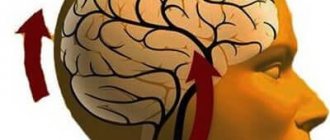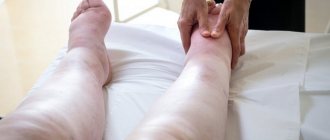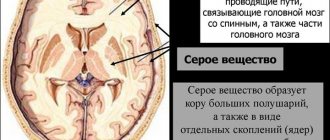Changes in the nature of the functioning of the nervous system do not always have an organic, structural origin.
Often pathological processes are determined by a purely functional nature. Therefore, it is not possible to detect atomic abnormalities in the brain, which significantly complicates the diagnosis.
It is especially difficult to identify disorders of a transient nature that manifest themselves in periods, in paroxysms.
NCD of the mixed type is a chronic neurological disease, which is accompanied by severe disturbances in the functioning of the heart and fluctuations in blood pressure over a wide range.
Neurocirculatory dystonia has its own ICD-10 code, F45.3, and is considered an independent diagnosis.
Related disorders, as a rule, are not characterized as separate nosological entities. For example, vegetative-vascular dystonia is a syndrome within other diseases, but not a full-fledged independent disorder and not a diagnosis.
NCD is characterized by a group of features that qualitatively distinguish it from other disorders: primacy, that is, independence from other disorders, functional nature, therefore it is not possible to detect organic changes, cardiovascular predominant symptoms.
What is neurocirculatory dystonia
Neurocirculatory dystonia of the hypertensive type is a disease that affects the human autonomic nervous, cardiovascular and respiratory systems. A characteristic feature of the pathology is chronic fatigue syndrome. Patients with this diagnosis complain of weakness, apathy, decreased ability to work, and have difficulty withstanding even minor physical exertion.
However, with a timely start of a therapeutic course and proper treatment, it is possible to stop the development of the pathological process, stabilize the patient’s condition and avoid extremely undesirable complications, such as heart failure.
NCD of the hypertensive type has several names, including:
- Cardiopathy of a functional nature;
- Neurosis of the heart;
- Neurocirculatory asthenia of the hypertensive type;
- Effort syndrome;
- Vegetovascular dystonia.
Hypertensive dystonia is not clearly defined and manifests itself with numerous, varied clinical signs.
Psycho-emotional instability is one of the signs of NCD
Forecasts
Mixed neurocircular dystonia does not lead to the development of heart failure or other life-threatening disorders in the functioning of the cardiovascular system. However, this does not mean that over time, against the background of the syndrome, another disease cannot develop, the cause of which will be completely different factors. That is why, after diagnosing mixed-type NCD, one cannot refuse regular examinations, the purpose of which is to monitor the functions of the cardiovascular system.
It should also be remembered that heart failure associated with NCD increases the risk of developing hypertension, that is, chronic high blood pressure. The later NCD is diagnosed and treatment is started, the higher the chance of a chronic form, and, consequently, its negative consequences. That is why it is necessary to contact specialists when the first symptoms appear, even if unexplained heart pain or pressure surges appear relatively rarely. The reason for diagnosing mixed-type NCD is the manifestation of symptoms within a month.
Pathogenesis of the disease
Experts identify a number of the following pathogenetic factors that contribute to the development of hypertensive type dystonia:
- Excessive stimulation of the nervous sympathetic system;
- Pathological changes in the trophic and metabolic functions of certain glands;
- Disruption of the relationship between brain areas;
- Excessively high rates of excitability of specific formations responsible for the functions of internal organs and systems.
The pathology can occur in mild, moderate or severe form.
NDC classification
According to the established classification, there are 4 types of neurocirculatory dystonia:
- Hypotensive - manifested by a periodic decrease in blood pressure to 90 to 60 mm. rt. Art. During an exacerbation, patients complain of weakness, malaise, and pronounced discomfort.
- Cardiac - manifested by rapid heartbeat, irregular heart rhythm, and painful sensations localized in the chest area.
- Hypertensive - this type of neurocirculatory dystonia is characterized by a periodic increase in the patient’s blood pressure.
- Mixed is a complex form of pathology in which clinical signs characteristic of the 3 types of NCD described above appear.
This is the most common classification of the disease, but there are others. According to the symptoms of the pathology, hypertensive asthenia is:
- Respiratory;
- Asthenic;
- Cardiological;
- Tachycardial;
- Vegetative-vascular;
- Neurotic.
According to the etiology of the disease, neurocirculatory dystonia of the hypertensive type is divided into toxic-infectious, genetic, psychogenic, and mixed reflex. The disease can also be caused by hormonal disorders, excessive physical exertion, and psycho-emotional shocks.
Degree of development of pathology
Severity
The severity level of NCD can be as follows:
| Severity | Symptoms |
| Weak |
|
| Medium-heavy |
|
| Heavy |
|
Reasons for the development of pathology
Hypertensive dystonia is a neurogenic disease, which can be provoked by the following reasons:
- Infectious processes occurring in acute or chronic form;
- Depressive states;
- Pregnancy;
- Poisoning, intoxication of the body;
- Frequent stressful situations and psycho-emotional shocks;
- Sexual disorders;
- Overwork;
- Traumatic injuries;
- Intoxication of the body with alcoholic beverages;
- Excessive prolonged exposure to ultraviolet radiation.
These factors contribute to disruption of metabolic regulation in the area of the cerebral cortex and hypothalamus, which leads to disorders of the functions of the nervous system.
The high-risk group, according to medical experts, includes:
- Persons suffering from hormonal imbalances;
- People with a certain hereditary predisposition to the cardiovascular and central nervous systems;
- Persons leading a sedentary, sedentary lifestyle;
- Patients with excessive excitability of certain brain areas.
The development of neurocirculatory dystonia of the hypertensive type is also influenced by the character, daily routine and lifestyle of a person. People most susceptible to the disease are people suffering from chronic lack of sleep, working night shifts, having problems of a socio-economic nature, self-centered people and selfish people.
The development of NCD is based on dysfunction of the hypothalamus due to internal and external causes.
What are the causes?
Teenagers most often suffer from the disease. This is due to the fact that at an early age, not all organs are formed and strengthened; under the influence of stress or other harmful external influences, the increased load causes disruption of blood vessel contractions. The initial problem, which serves as the foundation for cardiac-type NDC, is always individual. When pathology occurs, the following factors are always present:
- Overwork of the body. Physical and psychological stress above normal.
- Violation of sleep and rest patterns
- A sharp change in climatic conditions. The main role here is played by a sharp drop in atmospheric pressure
- Unexpected or prolonged stress
- Excessive environmental pollution. This also includes exposure to toxins in hazardous industries.
- A hormonal surge associated with a certain life period. Transitional age, pregnancy, menopause
- Lack of physical activity or, conversely, its excessive presence
- Genetic predisposition. People whose relatives had chronic diseases of the cardiovascular system suffer more often from the disease.
According to statistics, women are at greatest risk. They experience stressful situations more difficult, which cannot but affect their health. The likelihood of developing NCD directly depends on the type of personality and character. Expressive people, who tend to take things personally, are more likely to suffer from heart problems than others.
Symptoms and signs of the disease
Hypertensive dystonia is characterized by slow development and chronic course. At an early stage and during remission, the disease does not manifest itself with any specific clinical signs.
With the progression of the pathological process, as well as during exacerbation, the following characteristic symptoms of neurocirculatory dystonia of the hypertensive type occur:
- A feeling of heaviness localized in the chest area;
- Painful sensations in the heart, mainly stabbing or aching in nature;
- Dyspnea;
- Permanent lack of appetite;
- Blueness of the upper and lower extremities;
- Increase or decrease in blood pressure;
- Nausea and vomiting;
- Depressive states;
- Sleep disorders (insomnia at night and increased sleepiness during the day);
- Psycho-emotional instability, sudden mood swings;
- Unreasonable anxiety, restlessness, irritability;
- Cardiophobia;
- Obsessive states.
NCD attacks can occur with mental, physical, emotional fatigue, after alcohol abuse, during premenstrual syndrome.
Symptoms of NCD
In some patients, dystonia of the hypertensive type is manifested by a tachycardial syndrome, accompanied by increased heart rate, increased upper blood pressure, decreased performance, and a sensation of pulsation localized in various parts of the body.
With vegetative-vascular syndrome, patients with neurocirculatory dystonia complain of sudden jumps in blood pressure, attacks of headaches, excessive sweating, increased fatigue and a feeling of heat in the body.
Often types of neurocirculatory dystonia are accompanied by respiratory disorders and respiratory dysfunction. Patients feel the presence of a foreign body localized in the trachea, they lack air, and it becomes difficult to breathe.
According to statistics, about 64% of patients diagnosed with neurocirculatory dystonia of the hypertensive type are faced with manifestations of panic attacks, which occur mainly due to physical or mental fatigue, during the period of premenstrual syndrome. This condition is accompanied by the following unpleasant symptoms:
- Nausea;
- Attacks of suffocation;
- Tremor;
- Numbness, decreased sensitivity of the upper and lower extremities;
- Painful sensations localized in the abdominal area;
- Fear of death.
For several days after the end of the attack, patients complain of weakness, apathy, loss of strength, and general malaise.
Panic attacks are one of the manifestations of NCD
Neurotic disorders
According to statistics, every second patient with neurocirculatory dystonia has neurotic disorders. For example, this applies to depression or anxiety. With an anxiety disorder, the patient periodically experiences panic attacks, which are accompanied by a strong feeling of fear. The patient is very worried for various reasons. For example, he is afraid of suffocating, dying, or not waking up. If such attacks are repeated frequently, this indicates that an anxiety disorder is developing. At the same time, patients are very restless and suspicious. They sleep poorly and often wake up for no reason. They find it very difficult to sleep.
Every fourth patient with neurocirculatory dystonia suffers from depression. She can be both hypochondriacal and anxious. Mood worsens or may change dramatically throughout the day.
If a patient has a hypochondriacal disorder, then he is constantly busy with his own health. He always worries about what the outcome of this or that illness will be. Typically, people with such disorders try to visit the hospital more often. They constantly complain to doctors, each time finding new symptoms. They have a tendency to constantly measure pulse, blood pressure, and body temperature. Such patients also always try to find new methods of treatment.
Diagnostic methods
Diagnosis of neurocirculatory dystonia begins with examination of the patient, study of the present symptoms, and analysis of the results of the collected anamnesis. In most cases, patients experience the following manifestations characteristic of this pathology:
- Wet, cold upper and lower extremities are bluish in color;
- Anxiety and psycho-emotional instability;
- Shallow breathing;
- Dilated capillaries, clearly visible through the skin;
- Redness of the facial skin;
- Hyperventilation;
- Unstable heartbeat;
- Rapid pulse;
- Sudden changes in blood pressure;
- The presence of systolic murmurs in the heart.
After this, patients are prescribed an ultrasound examination of the heart and an electrocardiogram. If there are symptoms characteristic of hypertensive dystonia, as well as negative T-waves on the cardiogram, additional examinations are carried out in order to make an accurate diagnosis:
- Orthostatic tests - monitoring of cardiac activity in a supine and then in a standing position. In the presence of NDC, the manifestation of negative T waves increases;
- The hyperventilation method involves asking the patient to breathe intensely for 45-50 seconds, after which the pulse is measured. The development of neurocirculatory dystonia is indicated by a rapid heartbeat (up to 100%) and the appearance of T-waves on the cardiogram;
- Potassium tests are performed on an empty stomach. Before the examination, the patient takes a small amount of potassium chloride diluted in tea. A positive result is the formation of negative teeth.
Specialists also conduct a cardiogram during the rest period and after physical activity. In the case when a person experiences rapid heartbeat during recovery, hypertensive dystonia is diagnosed.
Orthostatic tests are one of the methods for diagnosing NCD
How to treat hypertensive type NCD
Treatment of hypertensive type NCD begins with the elimination of factors that provoke the development of the disease. In the case of a neurotic form of pathology, stabilization of the patient’s psycho-emotional state, elimination of stressful situations, and normalization of family relationships may be sufficient for recovery.
If the cause of the disease is overwork, then the person is advised to minimize physical activity. The therapy is complemented by methods of auto-training, relaxation, and psychotherapy.
Drug treatment of neurocirculatory dystonia involves the use of the following medications:
- Tofisopam;
- Diazepam;
- Chlordiazepaxide;
- Mebicar;
- Phenazepam.
Sedative, sedative, hypnotic medications, tranquilizers and antidepressants should be used exclusively as prescribed by a doctor, strictly observing the dosage recommended by the doctor, the regimen and the duration of the therapeutic course.
Good results for neurocirculatory dystonia are provided by drugs belonging to the pharmacological group of cerebroangioprotectors (Cinnarizine, Vinpocetine). These medications quickly and effectively relieve attacks of dizziness, headaches, and help normalize blood circulation and microcirculation processes localized in the brain area.
Packaging of Cinnarizine tablets
Treatment
It is necessary to find the cause of the disease and carry out etiological treatment. Often this contributes to a significant improvement in the patient’s condition or even recovery.
Symptomatic and non-drug treatment
It is necessary to eliminate traumatic psychological factors, sanitize foci of chronic infection in the nasopharynx and oral cavity, and eliminate occupational hazards. It is necessary to rationally limit excessive physical activity. If necessary, hormonal treatment is indicated (for example, during menopause). Individual and group psychotherapy and auto-training are of great importance.
Drug treatment
Drug treatment may include:
- preparations of valerian and motherwort;
- tranquilizers (Grandaxin);
- antidepressants (amitriptyline);
- nootropic drugs (piracetam);
- cerebroangiocorrectors (Cavinton).
These medications help normalize brain function, relieve feelings of fear and tension, improve metabolism and blood supply to the brain.
For tachycardia at rest and frequent sympathoadrenal crises, as well as for arterial hypertension, the use of beta-blockers (anaprilin, atenolol, metoprolol and others) is indicated.
Herbal medicine is recommended using infusions containing chamomile, lily of the valley flowers, fennel fruits, peppermint leaves, valerian root, motherwort herb, lemon balm, and linden blossom. Taking herbs should continue for a long time (up to six months or more).
Physiotherapy
Physiotherapy helps improve well-being during NCD. Applicable:
- electrosleep;
- electrophoresis;
- water procedures (showers, douches, baths);
- aeroionotherapy;
- restorative massage, including acupressure;
- acupuncture.
General strengthening and adaptation therapy plays an important role:
- healthy lifestyle;
- therapeutic nutrition;
- weight loss;
- physiotherapy.
You can also take adaptogenic drugs: eleutherococcus, ginseng, lemongrass, Rhodiola rosea, zamanikha, aralia. They should be taken under control of blood pressure and pulse.
Patients with NCD can undergo sanatorium-resort treatment in areas with a mild climate, without sudden changes in temperature and atmospheric pressure. These are local sanatoriums, as well as hospitals in the Kaliningrad region, Crimea, and Sochi.
When using medications, it is extremely important to know that only a doctor can prescribe them and determine the dosage. When using herbal medicines, it is necessary to determine whether the patient has allergies.
Video on the topic “Vegetative-vascular dystonia”
Source: doctor-cardiologist.ru
Preventive actions
You can avoid the development of hypertensive type dystonia or exacerbation of the disease by following the following recommendations from specialists:
- Avoid overwork;
- Get proper rest, devoting at least 8 hours of sleep throughout the day;
- Avoid stressful situations;
- Give the body regular, moderate physical activity;
- Lead a healthy lifestyle by giving up bad habits;
- Promptly treat diseases of a cardiac, neurological, hormonal, or vascular nature.
NCD of the hypertensive type in adults is a fairly widespread disease that significantly reduces a person’s ability to work and quality of life. With proper, timely treatment, complete recovery and restoration of normal functioning of the body is possible. However, experts note that in order to achieve a stable, positive result, treatment of pathology must necessarily be accompanied by correction of the patient’s lifestyle!
Treatment
Treatment of neurocirculatory dystonia is complex:
- normalization of lifestyle and nutrition;
- creating psychological comfort;
- phytotherapy;
- drug therapy.
Normalization of lifestyle
Treatment of NCD is impossible without compliance with the patient, that is, the patient himself must be interested in treatment and make every effort to do so. With lifestyle changes, especially in adult patients, complete recovery from dystonia is possible even without drug therapy:
- normalization of sleep - at least eight hours a day, preferably night sleep;
- nutrition – proper nutrition is the most effective prevention of most pathologies;
- giving up harmful addictions - this concept includes not only giving up alcohol, smoking and drugs, but also this applies to the so-called “caffeine addicts”, that is, people addicted to coffee and tonic drinks;
- physical activity - for the hypotonic type, treatment involves intense dynamic loads; for other types, a complex of therapeutic exercises with adequate load is also selected.
Psychological comfort
An equally important stage of treatment in the diagnosis of neurocirculatory dystonia is the formation of a psychological optimum. The severity of neurosis is relieved by the following methods:
- psychotherapy – an experienced psychotherapist, even without medication support, is able to bring a person out of a state of stress, depression, and neuroses;
- massage – depending on the type of pathology, it can be relaxing (hypertonic) or tonic (hypotonic type of dystonia), relieves the severity of neuroses;
- acupuncture - a traditional method of oriental medicine is designed to normalize nervous regulation when exposed to certain points, the method is effective even with simple pressure on these points without the use of special needles, recommended in courses for the treatment of dystonia;
- music therapy - sound vibrations of various frequencies, when properly selected, can balance the sympathetic-parasympathetic system, reduce or increase blood pressure, and significantly reduce pain; is an alternative treatment for dystonia.
Phytotherapy
It belongs to the methods of traditional medicine, which are approved for use in all age categories of patients, has a minimum of adverse reactions, is publicly available and has been proven effective in the treatment of dystonia.
Preference is given to herbs and herbs that have a sedative effect on the nervous system. These include:
- motherwort;
- valerian;
- mint;
- peony;
- red viburnum and other medicinal plants.
With hypotonic manifestations of dystonia, it is necessary to tone the vascular system. This effect is achieved by the following folk remedies:
- ginseng;
- Eleutherococcus;
- quince;
- snakehead and others.
Drug therapy
The following groups of drugs are used to treat dystonia.
- Drugs with sedative properties, for example:
- Novo-passit is a herbal remedy that is effective for phobic disorders, neuroses, stressful conditions, and various types of dystonia.
- Persen – also based on plant components, normalizes nervous regulation, and is used for stress disorders.
- Medicines with cardiotrophic action and normalizing vascular tone:
- Elkar is a vitamin preparation that improves metabolic processes, including in the myocardium and nervous system.
- Vinpocetine - affects metabolic processes in the brain, improves blood rheology.
- Antidepressants, for example:
- Azafen is an antidepressant, normalizes mood, helps relieve depression, and is used for stress.
- Seduxen is also a drug from the tranquilizer group, used to treat depression and stress disorders.
Doctors' recommendations for the treatment of dystonia are based on a combination of various treatment methods and minimizing drug intervention.
Source: SilaSerdca.ru











